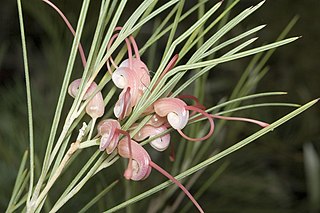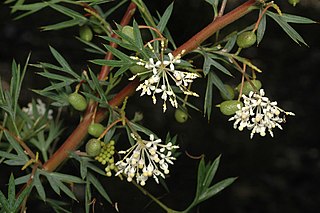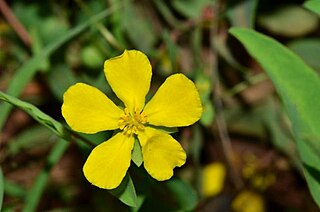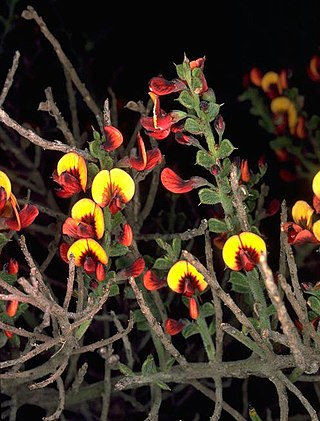
Banksia purdieana is a species of bushy shrub that is endemic to Western Australia. It has broadly linear, pinnatipartite leaves with sharply-pointed lobes on the sides, yellow flowers in heads of about eighty and egg-shaped follicles.

Eremophila dichroantha, also known as bale-hook eremophila, is a flowering plant in the figwort family, Scrophulariaceae and is endemic to the south-west of Western Australia. It is a shrub with many ascending branches making the plant appear broom-like. It has small, hooked leaves and small, though abundant, violet to lilac-coloured flowers.

Grevillea excelsior, commonly known as flame grevillea or yellow flame grevillea, is a species of flowering plant in the family Proteaceae and is endemic to the south-west of Western Australia. It is an erect shrub or small tree with usually divided leaves with linear lobes, and clusters of orange flowers.

Melaleuca cliffortioides is a plant in the myrtle family, Myrtaceae and is endemic to the south-west of Western Australia. It is a small, prickly shrub very similar to Melaleuca podiocarpa but with fewer stamens in the flowers.

Melaleuca depressa is a plant in the myrtle family, Myrtaceae and is endemic to the south-west of Western Australia. It is a small, bushy shrub with clusters of yellow or cream flowers on the ends of its branches in spring.

Isopogon alcicornis, commonly known as the elkhorn coneflower, is a plant in the family Proteaceae and is endemic to part of the South Coast Western Australia. It is a low shrub with pinnately-lobed leaves and oval heads of hairy, white or pink flowers.

Allocasuarina grevilleoides is a species of flowering plant in the family Casuarinaceae and is endemic to the south-west of Western Australia. It is a small, spreading, dioecious shrub that forms a lignotuber, and has more or less erect, sharply-pointed branchlets, the leaves reduced to scales in whorls of four, the mature fruiting cones 9–14 mm (0.35–0.55 in) long containing winged seeds (samaras) 5.5–7.0 mm (0.22–0.28 in) long.
Verticordia stenopetala is a flowering plant in the myrtle family, Myrtaceae and is endemic to the south-west of Western Australia. It is a low shrub with small leaves and heads of pink to magenta-coloured flowers in late spring and early summer.
Grevillea eremophila is a species of flowering plant in the family Proteaceae and is endemic to the south-west of Western Australia. It is an erect shrub with leathery, linear to narrowly egg-shaped leaves with the narrower end towards the base, and creamy-white flowers.

Grevillea inconspicua, commonly known as Cue grevillea, is a species of flowering plant in the family Proteaceae and is endemic to the central-west of Western Australia. It is a prickly, densely-branched shrub with linear leaves and clusters of off-white to silvery grey flowers.

Grevillea oncogyne is a species of flowering plant in the family Proteaceae and is endemic to inland areas of Western Australia. It is an erect to spreading shrub with linear, sometimes lobed leaves, and clusters of red or pinkish red flowers.

Grevillea phanerophlebia, commonly known as the prominent vein grevillea and the vein leaf grevillea, is a species of flowering plant in the family Proteaceae and is endemic to a restricted part of the south-west of Western Australia. It is an erect, spreading or straggly shrub with divided leaves, the lobes linear, and white and cream-coloured to yellow flowers.

Grevillea uncinulata, also known as hook-leaf grevillea, is species of flowering plant in the family Proteaceae and is endemic to the south-west of Western Australia. It is an erect, open shrub with linear to elliptic leaves arranged in clusters along the branches, and small clusters of white flowers, the style with a yellow, orange or red tip.

Kunzea montana, commonly known as mountain kunzea, is a flowering plant in the myrtle family, Myrtaceae and is endemic to the south-west of Western Australia. It is a shrub or small tree with more or less round leaves and heads of cream-coloured to pale yellow flowers on the ends of the branches in late spring. It is an uncommon species, growing on rocky mountain slopes, but all populations are conserved in the Stirling Range National Park.
Goodenia eremophila is a species of flowering plant in the family Goodeniaceae and is endemic to inland areas of Western Australia. It is an ascending herb with linear to elliptic leaves and thyrses of blue flowers.
Teucrium myriocladum is a species of flowering plant in the family Lamiaceae and is endemic to the south-west of Western Australia. It is a shrub with small, hairy leaves and creamy-green flowers.

Hibbertia silvestris is a species of flowering plant in the family Dilleniaceae and is endemic to the south-west of Western Australia. It is a prostrate to more or less erect or spreading shrub with hairy young branchlets, elliptic to egg-shaped leaves with the narrower end towards the base and yellow flowers with seven to ten stamens on one side of two softly-hairy carpels.

Daviesia dielsii, commonly known as Diels' daviesia, is a species of flowering plant in the family Fabaceae and is endemic to the south-west of Western Australia. It is on intricately-branched shrub with sharply-pointed, egg-shaped, vertically compressed phyllodes, and yellow and red flowers.
Lasiopetalum microcardium is a species of flowering plant in the family Malvaceae and is endemic to the south-west of Western Australia. It is a low, spreading or straggling shrub with hairy stems, heart-shaped leaves and blue, purple or white flowers.
Cryptandra polyclada is a species of flowering plant in the family Rhamnaceae and is endemic to the southwest of Western Australia. It is a low, spreading to mat-forming or erect shrub with white or cream-coloured, tube-shaped flowers. It was first formally described in 1904 by Ludwig Diels in Botanische Jahrbücher für Systematik, Pflanzengeschichte und Pflanzengeographie from specimens collected near Tammin. The specific epithet (polyclada) means "many shoots".














